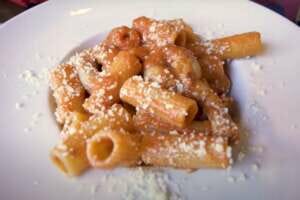Boast of Roman food tradition: the quinto quarto (fifth quarter) cuisine
Quinto quarto in Italian refers to a unique number of recipes of Roman cuisine. Here is the kitchen of the fifth quarter, pride of the Roman tradition.
Butchering, in fact, starts from dividing the animal into four basic parts, named quarti. Front and rear quarters from which to obtain the different cuts of meat. On the other hand, the word quartering precisely indicates the action of dividing into four parts (quattro quarti). Everything that was waste, ie the less noble parts, intestine, pancreas and thymus (the so-called animelle), the head and tail. As well as the feet, stomach, esophagus, lungs, and heart, therefore, is the fifth quarter. In a growing population, with a poor majority, it was unthinkable, in fact, to lose such a treasure. So, roman people found amazing and mysterious ways to obtain edible dishes from those parts of waste. Giving light, involuntarily, to dishes even tastier than the fine cuts.

The Jewish district of Rome offers traditional fifth quarter food. Courtesy of La Taverna del Ghetto
Neighborhood you go fifth quarter you find.
As is well known, the inhabitants of the districts of Rome are considerably parochial persons. Neighborhood against neighborhood, for centuries, to the sound of slaps, duels, and stones, but also sneers and rhymes, the Roman youth claimed its identity. In many different ways including pointing to the others for their food style. So, for the Trastevere inhabitants (Trasteverini), the citizens of the Rione Regola were the magnacoda (tail-eaters). For the Monticiani (living in Monti district) the Trasteverini were the magnaventricelli (heart-eaters) and so on.
The Top of the Roman quinto quarto.
Roman recipes using leftovers, were born, therefore, from the need not to waste food.are born. Like the pajata, which uses a part of the intestine of the animal. That only with the wisdom of tradition, turns a waste in a dish for kings. The Pajata is the essence of fifth quarter cuisine. Able to enchant with its taste, as much as shock or make the mouth of the stranger turn up who discovers the basic ingredients. Celebrated by the famous scene of the Italian movie Il Marchese del Grillo, it has thousands of admirers. The others simply never tasted it. To enjoy it is necessary to overcome the psychological resistance for eating entrails.

Rigatoni con la pajata top of roman recipes, for serial eaters only
Roman-style tripe: Trippa alla romana
This is truly a monument to traditional street food. Street food was born in Rome (yes, even in Naples). Traditionally, tripe was sold in the street by the so-called Tripparoli. Street vendors screaming around the streets, usually on Saturdays. As the classic saying goes: Thursday gnocchi, Saturday tripe. It is still found in some rare and traditional restaurants in the capital. Mainly in two versions: in white with meat sauce or with tomato sauce. To cook it properly it takes five or six hours, here this recipe is today anything but a poor dish. It is traditionally served with grated Pecorino romano or with Parmigiano Reggiano. Offered in super traditional restaurants, which, certainly boast a Roman chef in the kitchen. For pairing with wine, rosé or red wines of medium structure: Rossese di Dolceaqua, Lambrusco, Montepulciano d’Abruzzo.

trippa alla romana is the very roman-style tripe recipe
Sweetbreads and cerebellums: Animelle e testine
As previously mentioned, sweetbreads are mainly ingredients. And these ingredients are glands, thyme, and pancreas. Usually lamb, they are cleaned, lightly marinated in water and vinegar, floured and fried. Fried are also the buttered brains of the lamb. These are recipes that can be tasted in the Jewish quarter of Rome. A wine to pair with these recipes is a Rosato di Puglia, Moscato di Terracina, Zagarolo DOC

Franca preparing coratella in her family restaurant La Taverna del Ghetto
The coratella is a must to try

coratella con i carciofi – offal stewed with artichokes
It is essentially a stew of entrails, composed of heart, liver, lungs, esophagus spleen and sweetbreads. It seems that the name coratella derives from the fact that the entrails of sheep are used instead of cattle (corata). The Roman tradition wants it with artichokes. In addition, to being expertly prepared, it should be cooked by inserting the ingredients in a precise progression. Requiring different cooking times. It is usually blended with marsala wine, white wine or with lemon juice. The wine to pair with this rich recipe is, in our opinion, a full-bodied still red, with a balsamic aftertaste, not very tannic and persistent: Cesanese, Teroldego Rotaliano, Cerasuolo d’Abruzzo. Be sure to taste it only in the right places.
The oxtail, only in Rome with cocoa
When we talk about coda alla vaccinara, however, we must refer to two Roman districts. As mentioned before, the Regola district and the Testaccio district. For centuries, till the end of the 1800’s, the Mattatoio Flaminio, near the Rione Regola, supplied the ingredient to the quarter. After the closure of the slaughter, everything moved to Testaccio, a less gentrified area. This neighborhood was born around the famous Monte dei Cocci, a hill made of terracotta jars stacked over the centuries. The hill of Testaccio was quite hollow inside. Inside those ravines, most of the food and foodstuffs were well preserved, especially wine. So in Testaccio they gradually opened numerous taverns, some of which were supplied with the fifth quarter directly from the nearby slaughterhouse.

The recipe for the Coda alla Vaccinara
- 2 kg oxtail
- 2 cloves of garlic
- 1 onion
- Extra virgin olive oil
- Two glasses of white wine
- 1 kg of peeled tomatoes
- Rooms to taste
- Celery 1 stalk
- Pine nuts, a handful
- Raisins a handful
- Unsweetened cocoa to taste
In the traditional butchers of Rome, you can easily find oxtail. To cook this famous dish, let’s start with the sauté made in a crock pan with extra virgin olive oil (or lard according to the traditional recipe). Traditionally, better choosing an earthenware container. Firstly, fry the tail, then add the chopped onion, garlic and cloves. Once browned, blending with some white wine. Then add the peeled tomatoes (at least 1 kg). Cooking is very slow and prolonged with hot water until the meat comes, spontaneously, off the bone. About ten minutes before serving, add celery with pine nuts and raisins. Some also add unsweetened cocoa powder. Could sound weird, but in Rome it is not, and the taste is really surprising.
 Coda alla vaccinara and wine
Coda alla vaccinara and wine
The recipe matches with very persistent demi sec classic method sparkling wines. On the contrary, if you want to match white, it will have to be complex and structured with great body. Medium-bodied red wines are matching this recipe: Sangiovese, Cesanese, Carmignano or a Supertuscan. But many people prefers the white wine in pairing.
Do you want to know the real Roman cuisine? Contact us

 daniela cassoni
daniela cassoni Coda alla vaccinara and wine
Coda alla vaccinara and wine


 Daniela Cassoni
Daniela Cassoni 


